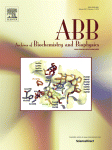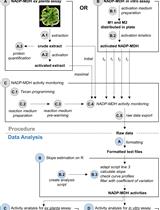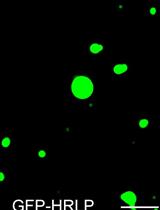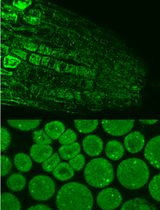- EN - English
- CN - 中文
Assay of the Carboxylase Activity of Rubisco from Chlamydomonas reinhardtii
莱茵衣藻中二磷酸核酮糖羧化酶活性的测定
发布: 2015年12月05日第5卷第23期 DOI: 10.21769/BioProtoc.1672 浏览次数: 10338
评审: Maria SinetovaAgnieszka ZienkiewiczAnonymous reviewer(s)
Abstract
The performance of the carbon-fixing enzyme, ribulose 1, 5-bisphosphate carboxylase/oxygenase (EC 4.1.1.39, Rubisco), controls biomass accumulation in green plants, algae and most autotrophic bacteria. In particular, the carboxylase activity of Rubisco incorporates carbon from CO2 to ribulose 1, 5-bisphosphate (RuBP) producing two molecules of 3-phosphoglycerate. Here a detailed protocol is given for the assay of the carboxylase activity of Rubisco from Chlamydomonas reinhardtii, a model organism for chloroplast studies and a fitting host for biotechnologically oriented genetic manipulation of the enzyme. Rubisco has to be pre-incubated with Mg2+ ions and bicarbonate to induce the catalytically competent active center (Laing and Christeller, 1976). Once Rubisco is activated, the assay of its carboxylase activity described here is based on the fixation of 14C-carbon dioxide/bicarbonate into acid-resistant radioactivity (Lorimer et al., 1977). Although a spectrophotometric assay is also available (Lilley and Walker, 1974), the method based on fixation of a radioactive substrate is irreplaceable when processing a large number of samples, and it is still the technique most often used for the determination of Rubisco activity.
Keywords: Ribulose 1,5-bisphosphate carboxylase/oxygenase (二磷酸核酮糖的羧化酶/加氧酶)Materials and Reagents
- Sephadex G-25 columns (PD-10) (GE Healthcare, catalog number: 17-0851-01 )
- Snap cap plastic tubes of 4 ml (Bio-Vials) (Beckman Coulter, catalog number: 566353 ) and tube racks
- Laboratory film (Parafilm M) (Thomas Scientific, Pechiney Plastic Packaging, catalog number: PM-996 )
- Chlamydomonas reinhardtii cell extract containing Rubisco
- Tris [2-amino, 2-hydroxymethyl, 1, 3-propanediol] (Trizma base) (Sigma-Aldrich, catalog number: T-1503 )
- Magnesium chloride hexahydrate (MgCl2.6H2O) (Merck Millipore Corporation, catalog number: 1.05833 )
- Sodium bicarbonate (NaHCO3) (Merck Millipore Corporation, catalog number: 1.06329 )
- D-Ribulose 1, 5-bisphosphate sodium salt hydrate (Sigma-Aldrich, catalog number: R-0878 )
Note: this is presented as a sodium salt hydrate, containing 4 Na+ and 3 H2O per molecule, with a global weight of 452.1 g/mol. - Sodium 14C-bicarbonate (52 mCi/mmol) (PerkinElmer, catalog number: NEC086H )
- 2, 5-diphenyl oxazol (PPO) (Sigma-Aldrich, Fluka, catalog number: 43140 )
- 1, 4-bis-(5-phenyl-2-oxazolyl) benzene (POPOP) (Sigma-Aldrich, Fluka, catalog number: 15150 )
Note: Product 15150 has been discontinued. - 2-Phenylethylamine (Merck Millipore Corporation, catalog number: 8.07334 )
- Toluene (Panreac, catalog number: 131745-1611 )
- Methanol (Scharlau S.L., catalog number: ME-0301 )
- Scintillation cocktail (Cocktail 22 Normascint) (Scharlau S.L., catalog number: CO-0135 )
- dH2O (deionized water) (processed by the Milli-Q system from Merck Millipore Corporation)
- Activation buffer (AB) (see Recipes)
- Reaction buffer (RB) (see Recipes)
- RuBP stock (see Recipes)
- Alkaline scintillation cocktail (see Recipes)
- Radioactive stock (see Recipes)
- 2 M Hydrochloric Acid (HCl) (VWR International, J.T. Baker®, catalog number: 6081 ) (see Recipes)
Equipment
- Radioactivity licensed laboratory equipped with a security extraction hood
- Thermostatic water bath (SBS, model: TI-03 )
- Stopwatch chronometer (Oregon Scientific Inc., model: TR118 )
- Vacuum oven (Thermo Fisher Scientific, Heraeus, model: Vacutherm VT6025 ) connected to an alkaline trap
- Radioactivity scintillation counter (PerkinElmer, model: Tri-Carb 2810 TR )
Procedure
文章信息
版权信息
© 2015 The Authors; exclusive licensee Bio-protocol LLC.
如何引用
Sudhani, H. P. K., García-Murria, M. J., Marín-Navarro, J., García-Ferris, C., Peñarrubia, L. and Moreno, J. (2015). Assay of the Carboxylase Activity of Rubisco from Chlamydomonas reinhardtii. Bio-protocol 5(23): e1672. DOI: 10.21769/BioProtoc.1672.
分类
植物科学 > 藻类学 > 蛋白质 > 活性
植物科学 > 植物生物化学 > 蛋白质 > 活性
您对这篇实验方法有问题吗?
在此处发布您的问题,我们将邀请本文作者来回答。同时,我们会将您的问题发布到Bio-protocol Exchange,以便寻求社区成员的帮助。
Share
Bluesky
X
Copy link


















